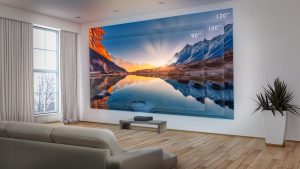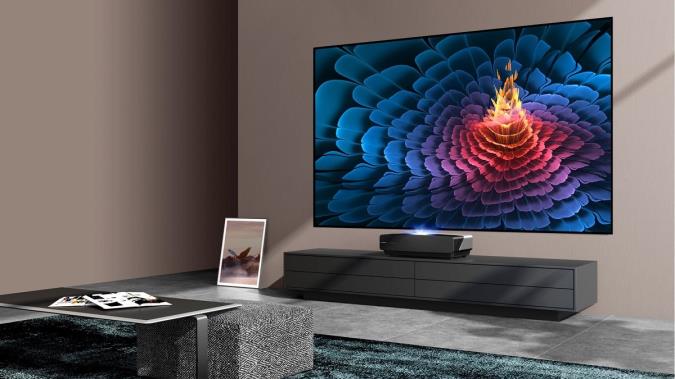What is Laser video Display?
Laser TV is overcoming economic and cost-effective problems due to its many advantages over more conventional TV systems.
What is Laser video Display?
Laser display is a term used to describe the use of laser light for entertainment purposes. Laser display systems are ideal for large displays and events because they create and scatter focused laser beams and effects, such as moving images and patterns, on walls, ceilings, or other surfaces over long distances.
The combination of laser lighting systems with music excites people through a variety of sound and visual effects, in which rhythmic beats are accompanied by various lighting effects that harmonize with the music and emphasize the mood of the music. In addition, massive and impressive multimedia laser displays can be created using smoke, fog, video projectors, and large water screens.
Laser color TV (laser TV) or laser color video display uses two or more separate light beams (lasers) modulated separately with different colors to produce a composite point scanned by a polygon mirror system and displayed across the screen.
They are using optical electronics to produce a color television display. These systems either work by scanning the entire image and modulating the laser directly at high frequency, much like electron beams in a cathode ray tube, or by optical scattering and then laser modulation and scanning each line in one turn. The line itself is modulated in much the same way as digital light processing (DLP).
History
Helmut K.V. Lotsch created the laser source for the TV or video show was proposed in the German invention 1 193 844. In December 1977, H.K.V. Lotsch and F. Schroeter described color laser television for conventional systems and the projection type and provided examples of its potential applications. Eighteen years later, the German company Schneider AG presented a prototype of a functional laser TV at IFA’95 in Berlin / Germany. However, due to the bankruptcy of Schneider AG, its prototype never developed into more than one ready-to-market product.
Laser lighting technology, introduced in 1966, remained far more expensive than those used in commercially available consumer products. At the 2006 Las Vegas Consumer Electronics Show, Novalux Inc., the Necsel semiconductor laser technology developer, demonstrated its laser light source for projection displays and a prototype “laser” TV with a rear projector. The first reports on the development of commercial laser TVs were published on February 16, 2006, with a decision on the availability of large-scale laser TVs expected by early 2008.
On January 7, 2008, at the Consumer Electronics Show 2008, Mitsubishi Digital Electronics America, a key player in the high-performance red laser and large-screen HDTV markets, unveiled its first commercial laser TV, the 65-inch 1080p model. A popular science writer was impressed by the color presentation of the Mitsubishi laser video display at CES 2008. Some even described it as so exciting that it seemed artificial. [14 ThislLaser TV, branded “Mitsubishi LaserVue TV,” sold for $ 6,999 on November 16, 2008, but the entire Mitsubishi Laser TV project was abandoned in 2012.
Laser TVs consume less power than LCD TVs. For example, a 100-inch laser TV consumes less than 300 watts, about one-half to one-third the size of an LCD TV. Laser TVs weigh about one-tenth of LCD TVs, and people can watch 80-inch laser TVs at a viewing distance of 3 meters.
Principles
The screen reflects Laser TV images and enters the human eye to form the image. The principle of laser TV is using DLP technology for image display. Take the DMD chip as an example. The DMD chip is the main component of imaging a laser TV. Millions of small mirrors are arranged, and each can rotate in a positive or negative direction at a frequency of tens of thousands of times per second.
Light is reflected directly through these small mirrors on the screen and forms an image. Due to the inertia of the human eye, the three primary colors, which radiate rapidly over a single pixel, are mixed and stacked together to form a single color.
Technology
Lasers may be an ideal replacement for UHP lamps currently used in projector displays such as TVs with rear projectors and front projectors. LG claims that the lifespan of its laser projector is 25,000 hours compared to 10,000 hours for a UHP. Today’s televisions show only 40% of the color spectrum that humans can potentially perceive.
Color TV requires light in three distinct wavelengths – red, green, and blue. While red laser diodes are commercially available, there is no green laser diode that can provide the required power at room temperature for a long time. Instead, you can use frequency doubling to provide green wavelengths. Several types of lasers can be used as double-frequency sources: fiber lasers, dual-interlayer lasers, external aperture dual lasers, vessels, and OPSLs (Optically Pumped Semiconductor Lasers). VCSELs have shown great promise and potential among dual-cavity lasers, which is the basis for lasers at twice the frequency on the mass production scale.
Blue laser diodes became widely available around 2010.
Specifications
The screen reflects Laser TV images and enters the human eye to form the image. According to ophthalmologists and professional evaluations, laser products are display products that are harmless to the naked eye. The screen has no electromagnetic radiation and is therefore eye-safe, healthy, and comfortable. Laser TVs are mostly large, supported by pure light sources, bright and original colors, and 4K screen resolution.

Laser TVs consume less power than LCD TVs. For example, a 100-inch laser TV consumes less than 300 watts, about one-half to one-third the size of an LCD TV. Laser TVs weigh about one-tenth of LCD TVs, and people can watch 80-inch laser TVs at a viewing distance of 3 meters.
Assembly
Laser signal modulation
An acoustic-optic modulator (AOM) introduces the video signal to the laser beam, which uses an optical refraction crystal to separate the beam at specific diffraction angles. The beam must enter the crystal at a specific angle to the brag of that AOM crystal. A piezoelectric element converts a video signal into vibrations in the crystal to create an image.
Horizontal and vertical refresh
A rapidly rotating polygon mirror gives the laser beam modulation of a horizontal refresh. The beam is reflected from a curved mirror onto a mirror mounted on a galvanometer, which provides vertical refreshment. Another way is to diffuse the beam and modulate the whole line simultaneously, like DLP, by reducing the maximum power required by the laser and keeping the energy consumption constant.
Display features
- Maintain full output power for laser life; Image quality is not reduced.
- It has a very wide color spectrum that can produce up to 90% of the colors that the human eye perceives by adjusting the laser wavelength.
- Ability to display 3D stereoscopic videos.
- You can project the image on any surface with any depth or shape by maintaining focus.
Applications
There are several types of laser projectors, one of which is based on the principle of a flying point of light that writes the image directly on the screen. A laser projector of this type consists of three main components – a laser source uses a video signal to deliver modulated light consisting of three clear spectral colors – red, green, and blue – followed by a flexible fiber optic waveguide. Transmits to a relatively small projection head.
The projection head or head deflects the beam according to the pixel clock and sends it to the screen at the desired distance. Such laser-throwing techniques are used in handheld projectors, planets, flight simulators, and other virtual reality applications.
Due to the special features of laser projectors, such as high depth of field, it is possible to broadcast images or data on any surface, even uneven. Typically, resolution, color space, and contrast ratio are higher than other projection technologies. For example, a laser projector’s on/off contrast is usually 50,000: 1 and above, while modern DLP and LCD projectors range from 1: 1000 to 40,000: 1. Compared to conventional projectors, laser projectors offer lower light output, but the brightness looks higher due to the very high contrast.
Development status
To further accelerate the adoption of laser displays, China’s Ministry of Science and Technology has prioritized “engineering and development of next-generation laser display technology” as one of the eight directions of industrial development. With the gradual resolution of related technical problems, the popularity of laser TV products in families remains a major goal.
At the end of December 2019, the CESI Laboratory of the National Institute of Electronics Standards of China and a team of ophthalmologists from Beijing Union Medical College Hospital conducted a research project on laser displays’ visual perception and eye pressure. In this study, 32 people were exposed to the same environmental conditions as laser and LCD TV. Blinking frequency and mental perception scores were compared and analyzed between displays. The results showed that watching LCD TV for a long time caused certain symptoms such as eye swelling, eye pain, fear of light, dry eye, and blurred vision while watching laser TV did not show any obvious visual changes or eye discomfort.
The combination of laser lighting systems with music excites people through a variety of sound and visual effects, in which rhythmic beats are accompanied by various lighting effects that harmonize with the music and emphasize the mood of the music.
vision
Laser TVs have many advantages over large-screen imaging compared to LCD LED TVs. The laser TV consists of a laser light source, an imaging module, a circuit control system, and a display in terms of technical composition. The advancement of technology in each of these units helps to increase market share compared to competing display technologies. In addition, laser light sources have the advantages of lower carbon generation, higher color gamut, and higher energy efficiency. The advancement of laser TV with better optical imaging technology could be profitable in the future home theater market.
Technical challenges
Lasers are the most expensive component of laser TVs. More advanced laser diodes usually require more semiconductor materials to produce, so reducing costs for the industrialization of laser TVs in the foreseeable future is a matter that will remain. Existing laser TV products typically use imported semiconductor devices. There are various competing technologies in the current solutions for large screens, such as LCD, OLED, and future Micro LED displays. Laser TVs need to continue to develop to maintain their competitive advantage to gain more market share.
Make more use of laser monitors.
Laser projectors are not only used for festivals, concerts, and nightclubs but can also be used effectively for advertising. There are many ways to combine laser light with other elements to display a massive multimedia laser. Using high-power lasers is the best way to brighten the night sky and use a prominent display laser.











